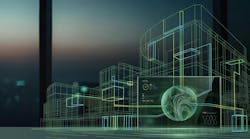Power has become the bottleneck to realizing Artificial Intelligence’s full potential. As AI workloads accelerate and digital infrastructure scales, the ability to secure reliable, sufficient power is now a critical barrier to growth. Recent findings from the 2025 Mid-Year Data Center Power Report, which surveyed hyperscalers, colocation developers, and utilities, emphasize this shift, revealing a considerable change in how decision-makers view power availability and resilience as a competitive advantage.
The grid is strained and needs to evolve to keep up with demand. Delays, permitting bottlenecks, and the inability to meet new capacity demands are slowing down or halting data center projects. At the same time, the power demand is growing exponentially, especially in hyperscale and AI factory environments.
Data Center Power Challenges Are Increasing
The pressure is real. According to the mid-year report, 84% of data center operators now consider power availability one of their top three site selection factors. In several key markets, utility interconnection timelines have extended well beyond planned timelines, in some cases exceeding two years. This marks a considerable change from just a year ago, when fiber optic proximity was the top priority. Today, power availability outweighs all other site considerations, a clear reflection of the new reality for the AI era.
This is not a temporary situation. Grid limitations, aging infrastructure, and prolonged permitting cycles are making it increasingly difficult for the centralized energy system to support the scale and speed of AI-driven digital transformation.
At the same time, data center operators cannot afford to slow down. The report forecasts a jump in median data center size from 175 megawatts to 375 megawatts by 2030. That is a 115% increase in just five years, primarily driven by AI training and inference workloads. These loads are continuous and high-density, leaving no margin for inconsistent power delivery.
Onsite Power Generation Is Becoming a Core Strategy
The industry is now focused on onsite power generation as a primary power strategy, not as a backup. The report shows that 38% of operators plan to use onsite generation as a primary source by 2030, and 27% say they expect their facilities to be fully powered onsite within the same window.
Data center operators are embracing modular energy solutions that can be deployed quickly, customized to specific site needs, and scaled as demand grows.
Modern onsite systems can also be highly efficient. Solid oxide fuel cells (SOFC) are among the cleanest and most efficient ways to generate power. They are robust and with their modular design, can be configured to meet high levels of availability. These systems can run on natural gas today and transition to low-carbon fuels in the future, helping data centers meet both reliability and sustainability goals.
Why Distributed Power Aligns with AI Infrastructure
The emergence of large language models and generative AI is reshaping energy demand profiles. AI loads tend to fluctuate constantly, placing unique pressure on power infrastructure. These oscillating workloads require fast deployment, high-quality power, and independence from unstable grids.
Onsite generation addresses these needs directly. Fuel cell systems, for example, can load follow and handle these dynamic load changes. These systems operate in parallel with or independently of the grid, giving operators the flexibility to meet demand with greater certainty.
Furthermore, fuel cell systems provide clean, always-on power without combustion and with minimal criteria emissions. Data center operators can also integrate these systems with carbon capture technologies or renewable inputs, such as biogas. This creates a path to carbon neutrality without compromising uptime or delaying deployment timelines.
How Can You Achieve More Resilient Data Center Power Infrastructure?
For leaders planning their next data center site or expansion, the path to resilience includes:
- Prioritize rapid deployment
Modular onsite systems can be installed in months, rather than years. They are easily permitted, which cuts construction timelines and unlocks earlier revenue from new capacity. - Invest in flexible, fuel-diverse technologies
Systems that run on natural gas today but can transition to hydrogen or biogas help balance near-term resilience with long-term sustainability. - Plan for grid independence
Instead of assuming the grid will catch up, design sites that can function reliably even without new grid connections. Onsite primary power makes this possible. - Align with national energy resilience priorities
Programs and funding initiatives increasingly support distributed energy solutions. Onsite generation meets both corporate and national resilience goals.
From Urgency to Opportunity in Digital Infrastructure
The current AI moment represents both risk and opportunity. Companies that act now can secure competitive advantages in site selection, deployment speed, and operational uptime. Those who delay may face mounting grid-related setbacks and lost opportunities in AI, edge, and the next generation of computing.
The 2025 Mid-Year Data Center Power Report is a clear message from industry leaders who are already moving toward onsite energy strategies. Power availability is no longer guaranteed. For the data center industry, power has become as important as real estate. Without access to sufficient, clean, and reliable energy, digital infrastructure cannot scale to meet AI’s demands or what may come next.
Onsite power generation offers a proven, flexible, and forward-looking solution. It supports business continuity, accelerates deployment, and enables sustainable growth. Data center operators who invest in onsite power today are not just solving today’s problems — they are building tomorrow’s energy foundation.
Interested in learning more? Download a copy of the 2025 Mid-Year Data Center Power Report here.
About the Author

Akhil Batheja
Akhil Batheja is the Director, Technology Strategy at Bloom Energy, where he leads initiatives at the intersection of innovation, decarbonization, and energy resilience. With over fifteen years of experience spanning energy storage, hydrogen, and renewable technologies, Akhil has played a pivotal role in shaping Bloom Energy’s strategic direction across domestic and international markets.
Since joining Bloom Energy in 2016, Akhil has held multiple leadership roles, including Director of Business Development and International Market Development. His work has focused on advancing clean energy solutions, forging strategic partnerships, and driving adoption of Bloom’s fuel cell and hydrogen technologies. Prior to Bloom, he held business development roles at Redaptive and Infosys, and began his career in engineering and product management at Aura Systems.
Akhil holds deep expertise in the energy transition space, and works with the industry on fuel cell innovation, decarbonation strategies, and the evolving energy landscape for data centers.



